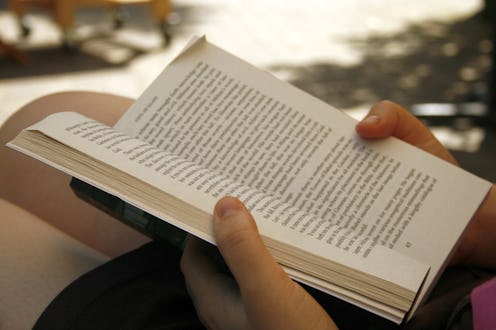Books
Paper vs. Pixel: A New Study Says . . .

I am one of those print copy romantics who holds fast to her massive paperback library. I do use an e-reader when it’s convenient, like when I pack for long trips or read on the go during my daily work commute, but when it comes to engaging deeply with a novel or studying a textbook, I have to have that print copy in hand. And according to a new study in the plethora of reading method research, there may be some method to my literary luddite madness: paperback-readers may have a cognition advantage over digital-readers.
Most studies in the past have suggested that, when it comes to comprehension, medium has little effect. However, researchers at the University of Stavanger in Norway and Aix-Marseille Université in France showed that paperback readers performed better when asked to re-sequence events of a story they just read, suggesting a connection between tactility and comprehension of time. What that all boils down to: There's a possibility that deep reading and the physical form of paper books may indeed be intertwined.
The New York Times reports that in the study, 50 grad students all with similar reading habits and e-reader agility were given a short story to read, half on paper, half on an Amazon Kindle DX, and then were thoroughly quizzed on various details of the text. For the most part, there were no obvious differences in the groups’ scores, except when it came to questions related to event sequencing. In these cases, Kindle readers scored much lower, sometimes performing twice as poorly.
“It’s interesting to us that the differences were both related to time and temporality — why is that?” Anne Mangen, who led the study in Norway, asked the Times.
Although researchers have yet to answer Mangen's specific "why," one Wired article suggests it may have something to do with the tactile cues paper provides — cues around which we can anchor our memories. These tactile stimuli allow us to form mental models of the text and subconsciously give readers a sense of position within the text.
“All those cues like what the page looks like, what the book felt like, all those little pieces help you put together the whole thing,” said Marilyn Jager-Adams, a cognitive psychologist at Brown University, said in an interview with Wired.
Spatial representation also plays a role — unlike the simulated pages of an e-reader, the pages of books are more often arranged in pairs.
“Especially for those of us with lots of traditional book exposure, we use physical pages as anchors for deep comprehension,” Jenny Thomson, a cognitive scientist at Sheffield University, told Wired. “E-paper takes away this comprehension prop to some degree, which I think could have subtle impacts for many people, at least until their reading system learns to adapt.”
While there are still tons of questions to answer in the never-ending print versus pixel war, the new study at least suggests that there's more to that physical sensation of grazing your finger over the pages of a book and physically turning the page than satisfying the simple pleasures of us old-fashioned technophobic bibliophiles.
Image: jepoirrier/flickr